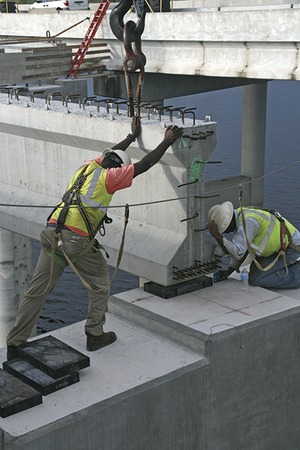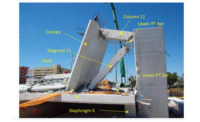

Contractors widening a 1.6-mile-long section of Interstate 75 in southwest Florida elected to build outside the box by using global-positioning technology to control two of the largest rubber-tired gantry cranes ever to work on a U.S. highway project.
Using GPS to guide a gantry, or straddle, cranes marks a first for a highway application, say executives at gantry-crane manufacturer Mi-Jack Products Inc., which supplied equipment for the Florida bridge project. Equally unusual is the size of the company's twin MJ-70 Travelift cranes, which feature clear spans of 84 ft, more than 20 ft beyond the typical width in this type of job, company officials add.
The innovation was born of necessity on the Florida bridge project, which involves adding two mainline lanes to the inside of a curving, 3,467-ft-long stretch of I-75 over the Caloosahatchee River. A joint venture of The de Moya Group and Leware Construction Co. needed the cranes to span the nearly 74-ft median gap between the existing twin-span bridge. Complicating matters was the section's 1° curve and 3.5% grade.
Steering Committee
Known for their broader use in ports, precast yards and other industrial settings, gantry cranes found on road projects are often used on straight sections and sometimes ride atop temporary rails.
But installing rails along the curving, sloping structures wasn't a viable option, project engineers say. Furthermore, controlling the cranes on rubber tires proved to be a challenge. At first, bridge crews attempted to manually steer the machines but quickly found the task was too tricky.
"We bumped into the [barrier] wall a few times," admits Scot Savage, general superintendent with Leware. "They're just so huge … the operator's got a lot of stuff he's got to watch besides the load." Installing the GPS system "has made a world of difference," he adds.
As the project's workhorses, the gantry cranes are constantly in use. "You can't get enough time with it," says Savage. "I've got to make sure if we're taking a load out, we're bringing a load back."
Workers have used the gantries, for which the contracting team reports paying about $750,000 each, to receive all construction materials on-site. The approach nearly eliminates lane closures and minimizes the need for barging in shipments, team members add.
GPS was not the only modification added to the gantries. In some areas of the project, the units also deliver or retrieve materials, such as piling, on sites located more than 50 ft below the work deck. This action, however, required reducing each hook block's reeving to four parts of line from eight.




Post a comment to this article
Report Abusive Comment